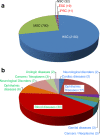The impact of transposable element activity on therapeutically relevant human stem cells
- PMID: 30899334
- PMCID: PMC6408843
- DOI: 10.1186/s13100-019-0151-x
The impact of transposable element activity on therapeutically relevant human stem cells
Abstract
Human stem cells harbor significant potential for basic and clinical translational research as well as regenerative medicine. Currently ~ 3000 adult and ~ 30 pluripotent stem cell-based, interventional clinical trials are ongoing worldwide, and numbers are increasing continuously. Although stem cells are promising cell sources to treat a wide range of human diseases, there are also concerns regarding potential risks associated with their clinical use, including genomic instability and tumorigenesis concerns. Thus, a deeper understanding of the factors and molecular mechanisms contributing to stem cell genome stability are a prerequisite to harnessing their therapeutic potential for degenerative diseases. Chemical and physical factors are known to influence the stability of stem cell genomes, together with random mutations and Copy Number Variants (CNVs) that accumulated in cultured human stem cells. Here we review the activity of endogenous transposable elements (TEs) in human multipotent and pluripotent stem cells, and the consequences of their mobility for genomic integrity and host gene expression. We describe transcriptional and post-transcriptional mechanisms antagonizing the spread of TEs in the human genome, and highlight those that are more prevalent in multipotent and pluripotent stem cells. Notably, TEs do not only represent a source of mutations/CNVs in genomes, but are also often harnessed as tools to engineer the stem cell genome; thus, we also describe and discuss the most widely applied transposon-based tools and highlight the most relevant areas of their biomedical applications in stem cells. Taken together, this review will contribute to the assessment of the risk that endogenous TE activity and the application of genetically engineered TEs constitute for the biosafety of stem cells to be used for substitutive and regenerative cell therapies.
Keywords: Adult stem cells; Genomic destabilization; LINE-1; Methylation; Pluripotent stem cells; Regenerative medicine; Restriction; Transposable elements.
Conflict of interest statement
Not applicable.Not applicable.The authors declare that they have no competing interests.Springer Nature remains neutral with regard to jurisdictional claims in published maps and institutional affiliations.
Figures




Similar articles
-
Transposable Elements in Pluripotent Stem Cells and Human Disease.Front Genet. 2022 Jun 2;13:902541. doi: 10.3389/fgene.2022.902541. eCollection 2022. Front Genet. 2022. PMID: 35719395 Free PMC article. Review.
-
Stem cells: the pursuit of genomic stability.Int J Mol Sci. 2014 Nov 14;15(11):20948-67. doi: 10.3390/ijms151120948. Int J Mol Sci. 2014. PMID: 25405730 Free PMC article. Review.
-
Mammalian transposable elements and their impacts on genome evolution.Chromosome Res. 2018 Mar;26(1-2):25-43. doi: 10.1007/s10577-017-9570-z. Epub 2018 Feb 1. Chromosome Res. 2018. PMID: 29392473 Free PMC article. Review.
-
What makes up plant genomes: The vanishing line between transposable elements and genes.Biochim Biophys Acta. 2016 Feb;1859(2):366-80. doi: 10.1016/j.bbagrm.2015.12.005. Epub 2015 Dec 17. Biochim Biophys Acta. 2016. PMID: 26709091 Review.
-
Retrotransposons in pluripotent cells: Impact and new roles in cellular plasticity.Biochim Biophys Acta. 2015 Apr;1849(4):417-26. doi: 10.1016/j.bbagrm.2014.07.007. Epub 2014 Jul 17. Biochim Biophys Acta. 2015. PMID: 25042909 Review.
Cited by
-
Transposable elements in normal and malignant hematopoiesis.Dis Model Mech. 2023 Aug 1;16(8):dmm050170. doi: 10.1242/dmm.050170. Epub 2023 Jul 28. Dis Model Mech. 2023. PMID: 37503739 Free PMC article.
-
Sensing of transposable elements by the antiviral innate immune system.RNA. 2021 Apr 22;27(7):735-52. doi: 10.1261/rna.078721.121. Online ahead of print. RNA. 2021. PMID: 33888553 Free PMC article.
-
Biomarkers of aging: from molecules and surrogates to physiology and function.Physiol Rev. 2025 Jul 1;105(3):1609-1694. doi: 10.1152/physrev.00045.2024. Epub 2025 Mar 20. Physiol Rev. 2025. PMID: 40111763 Free PMC article. Review.
-
Horizontal Gene Transfer: From Evolutionary Flexibility to Disease Progression.Front Cell Dev Biol. 2020 May 19;8:229. doi: 10.3389/fcell.2020.00229. eCollection 2020. Front Cell Dev Biol. 2020. PMID: 32509768 Free PMC article. Review.
-
CRISPR deletion of a SINE-VNTR-Alu (SVA_67) retrotransposon demonstrates its ability to differentially modulate gene expression at the MAPT locus.Front Neurol. 2023 Sep 29;14:1273036. doi: 10.3389/fneur.2023.1273036. eCollection 2023. Front Neurol. 2023. PMID: 37840928 Free PMC article.
References
Publication types
LinkOut - more resources
Full Text Sources
Other Literature Sources

